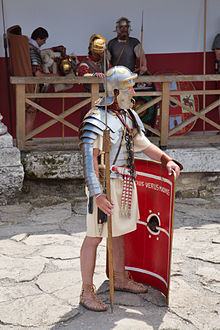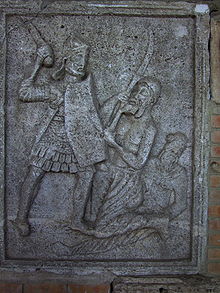- Manica (armguard)
-
The Latin word "manica" means a sleeve.[1] A manica was a type of iron or bronze arm guard, with curved and overlapping metal segments or plates, fastened to leather straps, worn by Roman gladiators called crupellarii, and later by soldiers.
Contents
Origins and early use
Roman troops fought crupellarii in the revolt of Florus and Sacrovir of 21CE.[2] By the time of Trajan's Dacian Wars, Roman troops were wearing manicae with the short-sleeved lorica segmentata as a protection against the falcēs, which could cut through or around the Roman legionaries' shields. Its use (along with metal greaves) is attested on several reliefs depicting that campaign, including the Tropaeum Traiani at Adamclisi and Trajan's Column. These seem to suggest that, like the lorica segmentata, it was only issued to Roman-born legionaries and not to auxiliaries. The Dacian campaign is the only one in which we have representational evidence for its use, and we do not know if its use in that campaign was widespread or rare.[3]

This article is part of the series on:
Military of ancient Rome (portal)
753 BC – AD 476Structural history Roman army (unit types and ranks, legions, auxiliaries, generals) Roman navy (fleets, admirals) Campaign history Lists of wars and battles Decorations and punishments Technological history Military engineering (castra, siege engines, arches, roads) Political history Strategy and tactics Infantry tactics Frontiers and fortifications (limes, Hadrian's Wall) Distribution and later use
Finds identified as manicae have come from Newstead, Carnuntum, Richborough, Corbridge, Eining on the Danube frontier, Leon, Carlisle, and Ulpia Traiana Sarmizegetusa.[4][5][6] These suggest that the manica was in use by the Roman military during the 1st century AD, independent from the Dacian wars. The sculpture at Alba Julia provides evidence of the manica in use in the 2nd and 3rd centuries CE by the military.[4] Ammianus describes Roman cavalry on parade in 350 CE as "Laminarum circuli tenues apti corporis flexibus ambiebant per omnia membra diducti." (Thin circles of iron plates, fitted to the curves of their bodies, completely covered their limbs).[4] Around 400CE, manicae are represented on the Column of Arcadius and in the Notitia Dignitatum.[4]
Construction and use
Bishop lists likely components as one shoulder plate, about 35 metal (ferrous or copper alloy) strips, 90-120 leathering rivets, 3 or 4 internal leathers, and one padded lining. The lining may have been a separate component, in order to avoid it being torn by the articulated metal plates. The metal strips were about 25 to 30 mm wide and 0.35 to 0.5 mm in thickness; they were longer at the top of the arm. Each strip had holes at its lower edge, through which flat-headed copper alloy rivets passed from the inside to hold the leather straps in place. It also had a hole punched at each end, which did not have a rivet and presumably served as an attachment point for an organic fastening. The lower few plates were in some cases riveted together, rather than articulated on leather. One depiction appears to show a manica terminating in a hand shape.[7]
The usual arm position depicted for Roman swordsmen is with the upper arm vertical and close to the torso, the forearm extended horizontally with the thumb uppermost. The plates were probably not long enough to cover the whole circumference of the arm, but would have extended from the upper arm down to the thumb, leaving an unprotected area at the back. The plates overlapped upwards, directing any blow to the inside of the elbow which had a particularly dense coverage of multiple plates.[7]
References
- ^ Article by James Yates, M.A., F.R.S., on p729 of William Smith, D.C.L., LL.D.:A Dictionary of Greek and Roman Antiquities, John Murray, London, 1875. [1]
- ^ The Manica. Roman Military Research Society. http://www.romanarmy.net/manica.htm accessed 18th August 2009, quoting Tacitus, Annales, III 43
- ^ Details of a manica built by a member of the modern Legion XX
- ^ a b c d The Manica. Roman Military Research Society. http://www.romanarmy.net/manica.htm accessed 18th August 2009
- ^ Legion XXIV's study of the hoard
- ^ National Museums Scotland catalogue entry
- ^ a b Lorica Segmentata - (Vol. I.) - A Handbook of Articulated Roman Plate Armour. Journal of Roman Military Equipment Studies, Monograph 1, 2002. ISBN 0 953 9848 42, ISSN 1477-8645. M. C. Bishop. Chapter 8. Other segmental armour. pages 68-72. http://www.scribd.com/doc/17405191/Lorica-Segmentata-Vol-I-Handbook-of-Articulated-Roman-Plate-Armour
Primary sources
Tacitus, Annales, III 43
Ammianus
External links
The Manica. Roman Military Research Society. http://www.romanarmy.net/manica.htm
Manica lamminata. Michael Simkins. Arma vol 2 no 2, Dec 1990, pages 23–26. ISSN 0960-9172 http://www.mcbishop.co.uk/arma/arma2-2.pdf
M.C.Bishop's lorica segmentata site at http://www.loricasegmentata.org
Bibliography
The World of the Gladiator- Susanna Shadrake
A Roman Frontier Post and its People- James Curle
See also
- Lorica segmentata
- Laminar armour
Categories:- Gladiatorial combat
- Ancient Roman legionary equipment
- Roman armour
Wikimedia Foundation. 2010.


